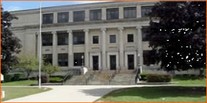
Batavia High School - Batavia New York

Fab 50's/Early 60's
Looking Back At ...

THE FABULOUS 50's
A Capsule View
Here are just a few of the headlines generated during this event packed decade:
Eisenhower Sends Troops to Little Rock
Quiz Shows Rigged, Admits Big Winner
Kefauver Exposes Mafia
Elvis Shakes and Shimmies
Home Bomb Shelters Are Big Sellers
MacArthur Fired by Truman
Hydrogen Bomb Test Awes Scientists
McCarthy Hearings Televised
The music on the jukebox has softened and the rumble of distant hot rods and muscle cars muffled, but the memories of those days are as fresh as yesterday.
The fabulous 50's was a remarkable energetic time, as so many optimistic people worked to put their lives back together after the difficult war years.
A Republican President sat in the White House for the first time since Franklin D. Roosevelt had taken over in the gloom of the Depression.
Television was the big new entertainment factor in the '50s. Milton Berle, Sid Caesar, Ed Sullivan, Jack Parr and Edward R. Morrow became household figures. Get-rich-quick instincts were fed by quiz programns that grew bigger and bigger until the bubble burst with the revelation that some of the most popular shows were rigged.
The loud and raucos sound of rock 'n' roll filled the land to such extent that many established songwriters, finding the kind of tunes they usually composed could no longer get a hearing, went into temporary retirement. Elvis Presley, grinding his hips and flailing a guitar, emerged as the new popular singing star while Frank Sinatra, who had been the Presley of the '40s until his singing career went into decline, made a startling comeback as a movie actor in "From Here to Eternity," a comeback which also returned him to favor as a singer. Folk music, which had previously had only a small coterie of devotees, reached a mass audience through the performances of the Weavers, Harry Belafonte and the Kingston Trio. Jazz, too, became fashionable, spurred by jazz festivals at Newport, Rhode Island, and Monterey, California. In serious music Van Cliburn won acclaim in the Soviet Union.
Two musicals, "My Fair Lady" and "Threepenny Opera," ran though a large part of the decade, the former on Broadway, the latter off Broadway.
Children and adults swung their hips in reckless circles to support hula hoops. Bulky-knit sweaters were worn by both sexes, while the use of color and individuality - even eccentricity - became more pronounced in men's clothing.
Mickey Mantle and Wille Mays were the new gods of baseball, but the most electric baseball moment of the 1950's came when Bobby Thompson of the New York Giants hit a three-run homer with two out in the bottom of the ninth to take the National League pennant from the Brooklyn Dodgers in 1951. Within a few years the Dodgers were in LosAngeles and the Giants were in San Francisco. The National and American Leagues, after a half a century of stability, started moving into new territory.
Note: Both these descriptions came from Reader's Digest "Down Memory Lane."
And Looking Back At ...
 THE EARLY / MID 60's
THE EARLY / MID 60's
A Capsule View
The tempo of life seem to pick up in the 1960's, to spread out in all directions in both an orderly and disorderly fashion. It was time to be where things were happening, "where the action is," in outer space, toward the moon and beyond.
The shaggy British Beatles set the musical pace and in there wake music became an electronic amalgam of guitars and organs. Young male hair grew longh while young female hair streamed down shoulders and back in loose abandon.
People were dancing again, doing the twist, the frug, the hully gully and other variations of a basic step that was much like the Charleston of the 1920's. Women's fashions harked back to the 20's, too, with cloche hats, waistlines lowered to the thighs and skirts that climbed and climbed until they reached above the knees.
Music with the Big Beat was everywhere. Transistor radios were glued to the ears of pedestrians who did not want to miss a note. Discotheques throbbed with recorded music and other gyrations of dancers.
The art world was no sooner rocked by the soup cans and comic-strip drawings of Pop Art than it was sent spinning by the optical illusions of Op Art. The "Theater of the Absurd" swept through small off-Broadway theaters, while vital new theatrical centers sprang up in communities large and small all across the country. On Broadway "Hello Dolly!" ran and ran.
Julie Andrews, having conquered the musical theater in the 1950's in "My Fair Lady," moved on to even greater success in Hollywood with "The Sound of Music" and "Mary Poppins." The new big musical luminary on Broadway, on television, on records and in concerts was singer Barbara Steisand. Bob Dylan led the folk-music world first to protest songs and then to a blend of folk and rock.
If there was a representative man of the 1960's, the collective sum of the contemporary fascination with sex, science and sadism, he might have been Ian Fleming's literary creation, the incredible James Bond - although, in the final analysis, Bond was scarcely more incredible than, in their owns words, were such real life figures of the sports world as Casey Stengel and Cassius Clay.




